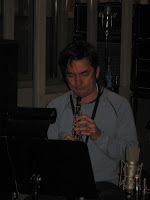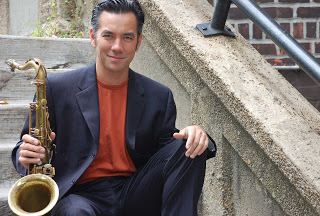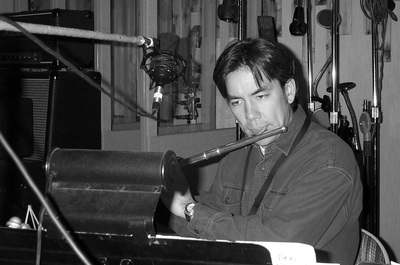| Numinous The Music of Joseph C. Phillips Jr. |
The Numinosum Blog
|
When I started Numinous back in the fall of 2000, I knew I wanted flexibility of colors in the woodwind section. Even though I'm a saxophone/woodwind player, I didn't want a saxophone dominant sound to the section. I also didn't want to have 10 woodwind players to cover saxophones, oboe, English Horn, flutes, clarinets, and whatever woodwinds I happen to write for. So the most natural solution was to have woodwind doublers who would be able to play multiple instruments. Of course with the demands of my music, I didn't want or need a typical jazz saxophone doubler: someone that plays maybe passable flute or clarinet but not well enough to match their saxophone abilities. In addition to being able to improvise well on all of the instruments, I really need musicians whose abilities on the other woodwind instruments are all fairly equal and could move easily between jazz, classical, and popular genres. And while there are great players like this everywhere, in New York we are blessed with an abundance beyond any composer's dream! With Broadway as well as the many professional orchestras, new music ensembles, and jazz bands here there are many musicians who not only fit my requirements, but because of the steady work on the Great White Way and other ensembles are also are willing to play more "adventurous" (and usually less lucrative) musical projects of people like me and my contemporaries.
I have been fortunate to always have great woodwind players in Numinous. And with Vipassana, I'm asking a lot of each player. Not only from a technical standpoint, but from sheer logistics: Reed 1 has to play 8 instruments (Piccolo, Flute, Alto Flute, Oboe, English Horn, Bb Clarinet, Soprano Saxophone, and Alto Saxophone), Reed 2 plays 6 (Piccolo, Flute, Oboe, English Horn, Clarinet, Tenor Saxophone) and Reed 3 plays 5 (Flute, Alto Flute, Clarinet, Bass Clarinet, Baritone Saxophone). Ben Kono, who plays Reed 1, has been with me from almost the beginning. Coming to an early rehearsal way back in the fall of 2000, he seemed to be tailor-made for Numinous. Not only does he play all the woodwinds with equal aplomb but is versatile enough to play and improvise in various genres and styles. In a recent interview, I said that since Ben has been with me from the beginning, his sound on various instruments (and what he brings to each instrument) has been in my head as I am composing for awhile now. Sure, other musician's can play well what I wrote, but without Ben it doesn't sound quite the same, since I think about what he brings to a specific instrument as I'm writing the music. For example, as I was composing "Stillness Flows Ever Changing", the second part of Vipassana, I was specifically thinking of Ben's soprano saxophone surfing over the weaving waves of melodies from the ensemble. And whether it is his soloing, like on "Stillness" or "Sweetness" which is a wonderful highlight for me from my first CD or his ensemble playing throughout Vipassana, Ben's tasteful and dynamic playing is highly valued and integral to Numinous. So I asked this maven of woodwinds some questions about himself and performing Vipassana: On Vipassana you play 8 different instruments, but truth be told, how many instruments can you play? What are some of the more unusual or interesting ones? As a woodwind specialist, I am classically trained on all five woodwind families of the orchestra: saxophones, clarinets (Bb and Eb soprano, bass), flutes, oboe/english horn, and bassoon. In practice, however, I tend to play some more than others, and I have left bassoon completely behind. About fifteen years ago or so, I became interested in indigenous musics from other countries and started to collect instruments from my travels, some of which I have incorporated into my own music. I have performed and recorded (in various degrees of success) on the "kena" flute from South America; the "khaen" pipes from Thailand; and the "dizi" flute from China. Of course, as a Japanese descendent I have a special interest in the shakuhachi flute which I was exposed to early on by my aunt who performs traditional Japanese music on the shamisen and koto. I played it on a Pulse Composers concert, and the lesson I learned is that playing western music on it is a lot more difficult than I imagined! So in answer, I am constantly adding and subtracting the number of instruments. What challenges does Vipassana pose for you as a woodwind player? Many instruments and instrument changes. And because of it's length and long phrases, it's quite a challenge endurance-wise to make it through the English horn solo at the end. I've learned to pace myself and take a few breaks during some long oboe passages preceding. And, rhythmically the music takes many twists and turns--sometimes an instrument behind you will be playing, literally, in a different time signature than you are, so you need to be alert to all the changes in pulse and meter. What do you like about Vipassana? Coming from a jazz background, I like that Vipassana is NOT that. It has some jazz elements and improvisation, but the general structure and vibe of the music shares more with classical and minimalist composition. Extended forms, non-traditional harmonies, lush orchestrations and textures (or almost none, sometimes) allow the soloist to explore some improvisational freedoms and possibilities not afforded by the more standard jazz environment. I find it easier to approach this music without preconception. I also like playing in a large ensemble where the volume never gets above a forte and more attention is paid to subtle dynamics. What do you find beautiful (or where do you find beauty)? As a parent of a curious three-year-old girl, I am finding beauty in places unexpected and long-forgotten. She forces me to slow down and contemplate the pattern a leaf makes in the snow, or the arc that a balloon makes when tossed into the air. I still love going to a museum and admiring a Matisse or a Rothko, but when I am with my daughter I can find the beauty in a fire-escape as well. And more and more I'm appreciating the beauty of silence, which is very rare indeed in the city. Who are your musician heroes? My musician heroes are too many to list properly. There are those that inspire me through listening to recordings, like Wayne Shorter, Keith Jarrett, John Coltrane; those that I have met and had discourse with on a more personal level like Joe Lovano, Paul McCandless and Michael Brecker; and those colleagues who are in the "trenches", like John Hollenbeck and Theo Bleckmann, who are involved in creating a new place for creative music. Then, there is Gary Campbell, a tremendous saxophonist who could have been a major jazz artist but chose to become one of the great educators and mentors of our generation. I guess, really any artist who dares to change the listeners' expectations of what is possible or acceptable and can do it on a level that touches the "human spirit" in us. If you could be flying over any place in the world, where would it be? Why? I would love to fly over the Sahara Desert. I think the vastness and beauty of it would blow my mind. And as Lawrence of Arabia said of it ,"It's clean". What is a book(s) that have inspired you? I don't seem to read a lot of 'inspirational' material, but something that I read recently did inspire me despite the tragic nature of it's subject. The book Impounded is a collection of photographs by Dorothea Lange, accompanied by essays and interviews of Japanese-Americans interned during WWII in the United States. Alongside the images of gross injustices by the U.S. government are images of a culture struggling to maintain it's strength and dignity under terrible conditions. So in the middle of a barren desert you can see a beautiful Japanese garden, or children attending an art school, or vegetable crops growing in carefully cultivated soil. I found the tenacity and patriotism of the wronged citizens to be an inspiration, although the situation was altogether shocking and reprehensible. When was the last time you've had that numinous feeling about something? I almost always feel that way when I return to my Vermont childhood home and take a walk in the woods--especially in the fall! Tell us something fun or interesting about you that most people wouldn't know or suspect? My mother steered me away from a career in art and into music because she thought it too competitive and unstable. What's next up for you in your own music career? I'm getting ready to record my own project of original music. And, like Vipassana, I will probably be playing close to eight instruments. I do this to myself. Check back soon for more insider tidbits about Vipassana! Numinous performs Vipassana Wednesday October 28, 2009 8 PM (one set only) $10 Brooklyn Lyceum 227 4th Avenue Park Slope Take the M, R Train to Union Street POSTED BY NUMINOUS AT 10:50 PM
0 Comments
Your comment will be posted after it is approved.
Leave a Reply. |
The NuminosumTo all things that create a sense of wonder and beauty that inspires and enlightens. Categories
All
|
Thanks and credit to all the original photos on this website to: David Andrako, Concrete Temple Theatre, Marcy Begian, Mark Elzey, Ed Lefkowicz, Donald Martinez, Kimberly McCollum, Geoff Ogle, Joseph C. Phillips Jr., Daniel Wolf-courtesy of Roulette, Andrew Robertson, Viscena Photography, Jennifer Kang, Carolyn Wolf, Mark Elzey, Karen Wise, Numinosito. The Numinous Changing Same album design artwork by DM Stith. The Numinous The Grey Land album design and artwork by Brock Lefferts. Contact for photo credit and information on specific images.



 RSS Feed
RSS Feed